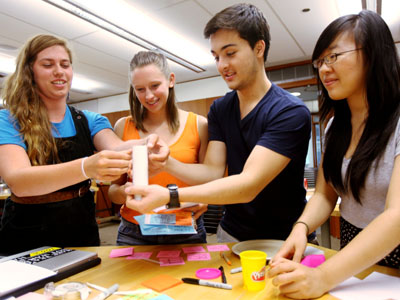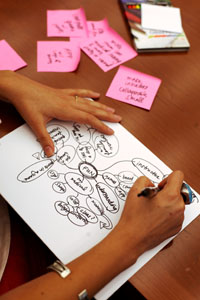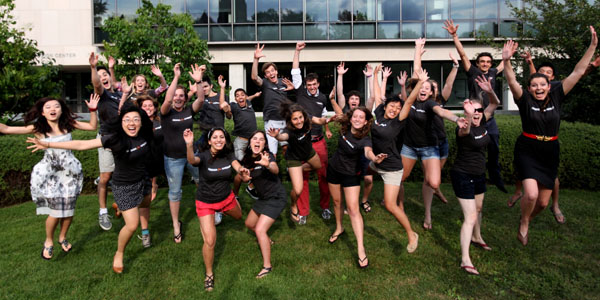Design for America Expands Nationally, Featured in Fast Company Magazine
Design for America, the Northwestern University student initiative that creates local and social impact through interdisciplinary design, has helped find solutions to everything from hand hygiene to diabetes education in its short, two-year history.
Now, it’s going national.
More than 20 students from eight universities across the country descended onto Northwestern in August for the first-ever Design for America Leadership Studio, which launched the expansion of the organization to “studios” around the country.
Students from Cornell, Barnard, Columbia, Dartmouth, Brown, and Stanford Universities, and well as students from University of California Los Angeles and University of Oregon Eugene spent a weekend learning Design for America’s values, processes, and how to effect change in their own communities.
“The overall goal was for everyone to get to know each other and establish a network of support, get to know DFA and its core values, and prepare to launch their own studios,” said Sami Nerenberg, director of operations for the initiative.
Students from the Cornell studio were featured on the October cover of Fast Company magazine as part of the magazine’s “United States of Design” article.
“A burgeoning national student organization called Design for America, started at Northwestern by Yuri Malina, Mert Iseri, Hannah Chung, and Liz Gerber, is bringing design-process thinking to students at nine universities across the country, who typically might imagine that design encompasses furniture, fashion, and little more,” writes Fast Company senior editor Linda Tischler.
 Design for America was conceived in 2008 by Elizabeth Gerber, assistant professor of mechanical engineering, when she realized the possibility of students learning design through service. She piloted the program with Northwestern students Mert Iseri, Hannah Chung, Yuri Malina, and others in February 2009. Since then, the initiative has held several “studios” throughout each year aimed at getting students involved in community projects. Students involved in the initiative have designed Jerry the Bear with Diabetes, an animatronic bear that educates children about the disease; hygiene solutions for a local hospital; and dishwashing solutions to save water in cafeterias.
Design for America was conceived in 2008 by Elizabeth Gerber, assistant professor of mechanical engineering, when she realized the possibility of students learning design through service. She piloted the program with Northwestern students Mert Iseri, Hannah Chung, Yuri Malina, and others in February 2009. Since then, the initiative has held several “studios” throughout each year aimed at getting students involved in community projects. Students involved in the initiative have designed Jerry the Bear with Diabetes, an animatronic bear that educates children about the disease; hygiene solutions for a local hospital; and dishwashing solutions to save water in cafeterias.
The initiative has inspired so many Northwestern students that they decided they couldn’t keep it to themselves any longer: they opened applications this spring for colleges who were interested in starting their own Design for America studios.
Eight schools were chosen, and the student leaders who created their DFA applications were invited to Northwestern for the Leadership Studio weekend.
Students spent Friday on a one-day design project: how to improve the lives of people with asthma. The students interviewed a mother and her five-year-old son and tried to frame and reframe potential problems. They then used Play-Doh, foam core, markers, and Post-it notes to brainstorm possible solutions. Some ideas worked (an underwater-themed hospital room where everyone, including doctors and nurses, wore breathing masks) while others did not (a less scary inhaler. The five-year-old said his inhaler wasn’t scary in the first place.)
 Students spent Saturday reflecting on their experiences with organizations and learning the core values of Design for America: to look locally, act fearlessly, and create fervently. They talked about working in teams and heard from coaches on how to best work with different communities. Students even heard from design sage Bruce Mau, designer and Distinguished Fellow of the Segal Design Institute at Northwestern, who shared his story and his design manifesto.
Students spent Saturday reflecting on their experiences with organizations and learning the core values of Design for America: to look locally, act fearlessly, and create fervently. They talked about working in teams and heard from coaches on how to best work with different communities. Students even heard from design sage Bruce Mau, designer and Distinguished Fellow of the Segal Design Institute at Northwestern, who shared his story and his design manifesto.
Students then spent Sunday learning how to run a DFA studio and how to scope projects: Are they daring, feasible, and applicable? Are they interdisciplinary? Do they make you excited?
“I was really inspired by the concept of design as imagining the future and then working systematically towards that future, and how important it is to live, work, and design with a purpose and to your idea,” said Annie Wu, a student at Brown University.
“The most important thing for me is that even though it’s a huge responsibility to be starting this studio, we have a huge amount of really talented and skilled help too,” said Sean Hammett, a student at Dartmouth University.
DFA organizers hope to make the Leadership Studio an annual event and hope to eventually spread the organization to more 50 universities over the next five years.
“By inviting their peers to campus this summer, the Northwestern students are realizing the original vision of creating a national network of student innovators,” Gerber said. “They are being transformed from observers to actors through and by design.”
